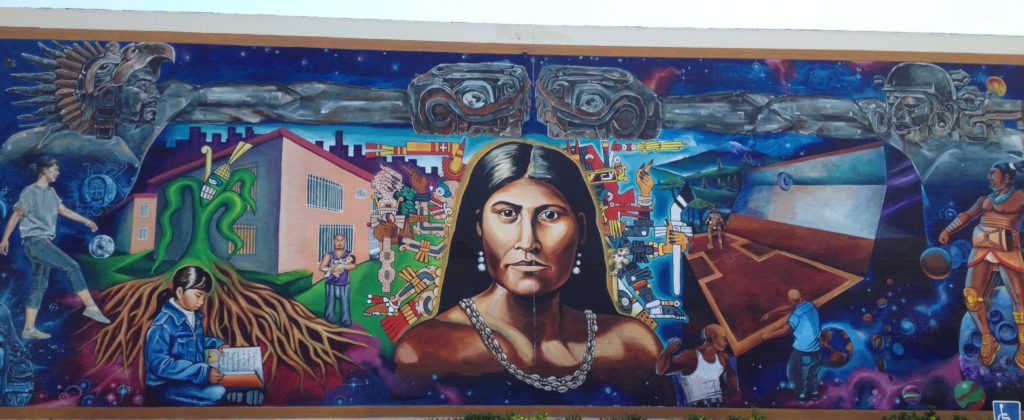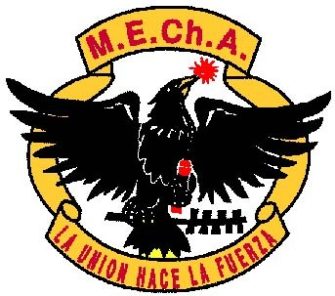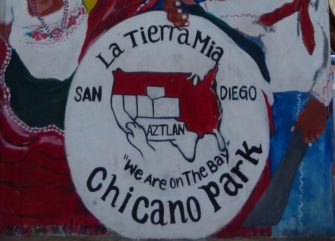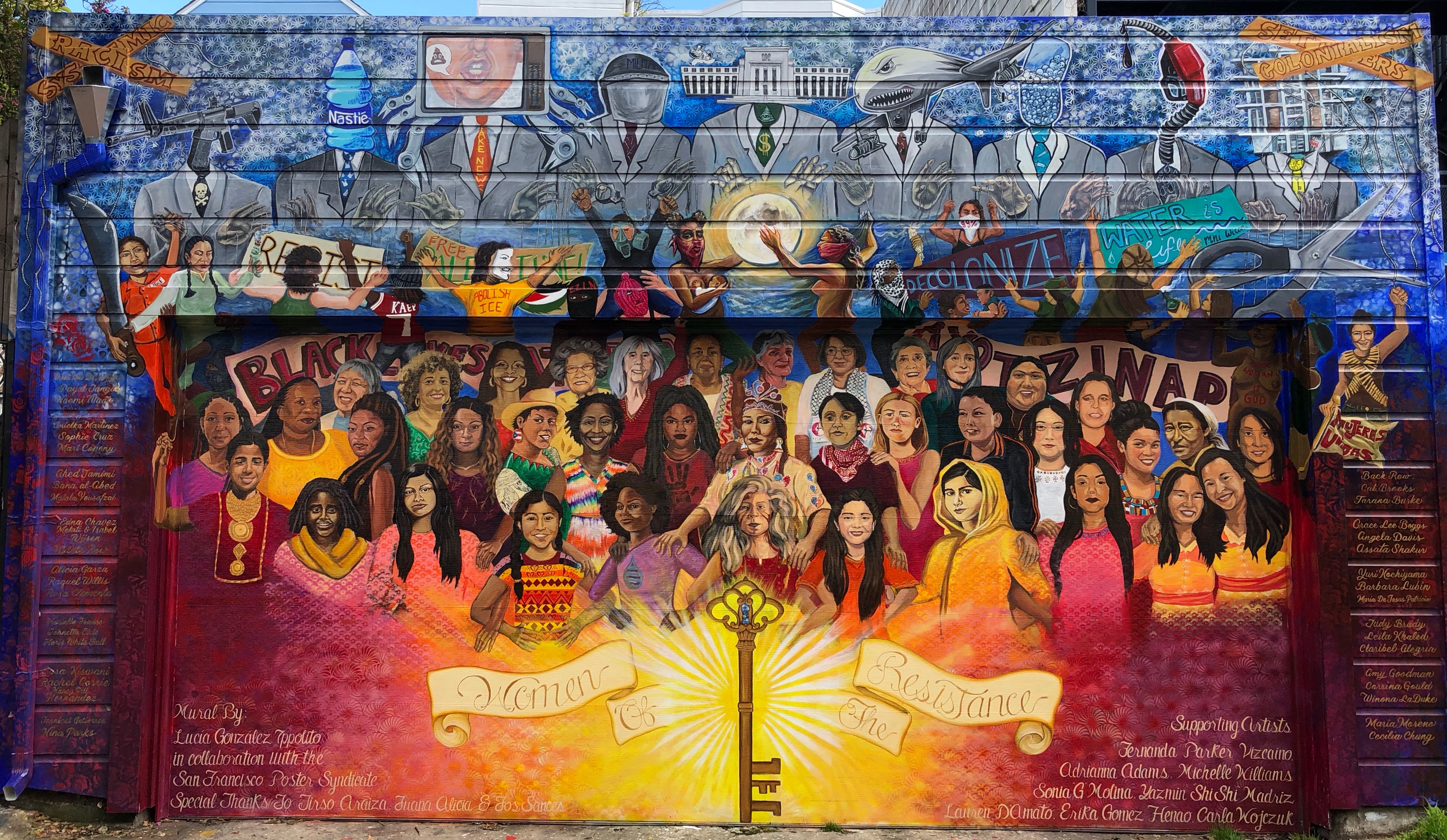
On March 31, 2019, student leaders from the Movimiento Estudiantil Chicanx de Aztlán (MEChA; the Chicanx Student Movement of Aztlán), a U.S. Latina/o/x organization present on many high school and college campuses across the country, voted to change their fifty-year old name. They decided that they had to drop two of the most mythically politicized facets: “Chicanx” and “Aztlán.” Although they haven’t decided on a final name, right now they have chosen an Espanglish acronym: Movimiento Estudiantil Progressive Action (MEPA). In an Associated Press story, some MEChA alumni criticized the students for running away from or trying to erase their history.
Given that the names “Chicano” and “Aztlán” have been contested for fifty years, by debating these terms and voting to alter their names these students are actively participating in that history. In a statement on the decision, their national board made clear that they are not disavowing earlier generations.
Becoming MEChA: Historical Context
In the late 1960s, across the country, students mobilized to demand courses and programs of study that decentered modern European thought and reflected a greater sensitivity to the full human experience. The struggle for self-naming was part of the struggle for self-determination and greater educational opportunity that proliferated among these movements. For those engaged in decolonial struggles, there was often a hope that pre-modern stories and traditions might offer fuel in resisting contemporary colonial structures. The names “Chicano” and “Aztlán” were themselves invested with meaning by young people who were searching for names and ideas that would reflect their self-perception better than the terms outsiders had placed upon them.
At the same time, these movements were always more diverse in composition and less unified in perspective than later narratives like to depict. As a student of Christian scriptures, I am familiar with the ways on-the-ground human diversity often gets flattened in the memorialization of supposed moments of origin. I partially offer this reflection in the hope that MEPA narratives can do a better job of remembering how much of their fifty-year history has involved a multiplicity of perspectives and ongoing contestation.
Dominant Chicano movement narratives offer a clear and progressive origin story that begins with the triumphal inclusion of Chicano and Aztlán as terms of self-identification. In March of 1969, possibly 1500 activists met in Denver with a focus on Chicano nationalism. The term “Chicano” had started to circulate among activists a few years before. It felt like a reclaiming of an older term, and a variety of myths about the exact origin of the word abounded, though many thought it came from “mechicano,” a reference to the indigenous Mexica peoples. “Chicano” was also deployed with pride in contradistinction to the derogatory names that had been placed upon “ethnic Mexicans” (a term I take from historian Ernesto Chávez in order to speak to the pan-ethnic conglomeration of diverse peoples) by outsiders since the United States had seized and conquered the northern half of Mexico in 1848. From the history of 19thand 20thcentury lynchings in the borderlands amid Anglo depictions of “dirty Mexicans” to the use of “Operation Wetback” as a name for a mid-20thcentury federal government operation of mass deportations, ethnic Mexicans had confronted a variety of slurs employed to justify violence.
During the 1969 conference, the poet Alurista wrote the preamble for El Plan de Aztlán, where he renamed the southwestern United States “Aztlán,” the land the Aztecs migrated from before moving to the Valley of Mexico and the land to which they promised to return. Alurista intentionally drew upon a myth that antedated European colonialism, a myth that invoked both a pre-Columbian past and a future where colonial sufferings have ended.

In choosing the name “Chicano” for themselves and “Aztlán” for the lands on which they met, activists refused dominant depictions of ethnic Mexicans as foreigners. Instead, the United States was the foreign interloper in a grander history. Chicano/a/x activists were claiming a deep ancestral connection to the lands on which they lived. Precisely because ethnic Mexicans had faced so many forms of displacement and erasure in U.S. history, the powerful longing for place that rests behind these names persists through fifty years of engagement with Aztlán.
In April 1969, more than one hundred ethnically Mexican students, staff, and faculty from twenty-nine of California’s public colleges and universities met in Santa Barbara in order to craft a plan for higher education. But they also brought together several distinct student organizations and combined them into one new group: MEChA. The name was meant to signal a radical vision and commitment to self-determination. They were not “Mexican American” but Chicano. They were a movement in Spanish. They were not in California but Aztlán, the mythical homeland of the people we call Aztecs. Collectively, they became a mecha, a “matchstick” or a “fuse.”
Contestations over Aztlán
Yet Chicanos were themselves a diverse group, and they were more divided over the name and their platform than the October 1969 publication of El Plan de Santa Barbara makes it seem. Chicana feminist and Santa Barbara steering committee member Anna Nieto-Gómez has long observed that the published text flattened out the diversity of voices and the plurality of visions that had been present in Santa Barbara. Nieto-Gómez tells a different narrative about the Chicano movement’s history. For her, certain questions and practices of internal contestation were always part of ethnic Mexican student activism.
Even in 1969, some young activists already wondered if the name “Chicano” represented too much of a break from their own past. The term “Chicano” was more commonly used within particular academic and activist contexts. What about friends and family who were not as educated in activist lingo? Many wondered whether the name worked to exclude rather than to unite.
Aztlán, with its promise of a once and future homeland, was also quite pliable in its imagination and reception. Some participants in the Chicano movement, as filmmaker Jesús Treviño describes in his autobiography Eyewitness, may have hoped for a more literal reconquest of Mexico’s northern territories. And some activists, like Alfredo Acosta Figueroa as he describes in his book La Cuna de Aztlán, may have really believed that they had found the literal homeland of the Aztecs in a specific place in California.
Most, however, quickly turned to a more spiritualized description, where Aztlán became more of a state of mind. They saw it as an alternate utopian space, or, as Luis Leal described it, “Aztlán symbolizes the spiritual union of the Chicanos, something that is carried within the heart, no matter where they may live or where they may find themselves.”
Current MEChA member from Seattle University, Nicolás Cruz, in his widely circulated paper criticizing Aztlán (“Reflections on Aztlán and Its Role in the Chicanx Student Movement”) makes note of the possibilities of this spiritualized approach. Cruz particularly engages with the analogy of what Israel means to different Jewish communities, highlighting their long history of contesting the meanings of homeland and diaspora. Yet, he still leaves that comparison wondering if spiritualizing Aztlán sufficiently addresses critics’ concerns.
Cruz’s criticisms and those of other student leaders target these visions of Aztlán as themselves implicated in colonialism, racism, patriarchy, heterosexism, ableism, and transphobia. In a move familiar to students of religion, many elder activists depict these criticisms as contemporary impositions that fundamentally misunderstand an ancient myth and the historical context of the movement from which these ideas emerged. But I would suggest that, even if we discuss them on different terms now, all of these critiques have long histories.

As early as the 1970s, some activists wondered if Aztlán relied too much on a romanticized, imperial vision. Aztlán, as it was imagined, partially derived its power from Spanish interpretations and manuscripts. The Mexicas, to whom “Chicano” supposedly referred, also colonized and dominated a great diversity of indigenous peoples before the Spanish arrived. Many ethnic Mexicans are indigenous but not Mexica. Additionally, in the last fifty years, the U.S. Latina/o/x population has grown and diversified dramatically. Many members of MEPA trace their ancestors to various parts of Latin America and not just Mexico.
Moreover, appealing to the Mexica people and to Aztlán grew out of a 1920s Mexican nationalist revolutionary mythos that valued racial mixture (mestizaje) rather than indigeneity. As Néstor Medina has succinctly outlined in his book Mestizaje, certain Mexican nationalists appropriated indigenous imagery even as they opposed indigenous rights and erased Mexicans of Asian and African descent.
Attempts to narrate and contest the complex racial stratification of the Americas have hundreds of years of history, even if, again, how we name those contestations now looks different. So too, in the case of the Chicano movement, do we find long-standing concerns about how indigeneity is respected in relationship to mestizaje. Indeed, indigenous ethnic Mexican objections to the concept of Aztlán may have been one of the most important factors in the decision to change the name. Even Alurista quickly rethought his positions, and his Nationchild Plumaroja (1972) sought to be more gender inclusive and more focused on indigenous traditions rather than mestizaje.
Since 1970s Chicano activism was borne out of solidarity with other minoritized communities, some activists also asked about the rights of other minoritized populations, such as African Americans, American Indians, and Asian Americans. Aztlán seemed to refuse other claims on a shared space.
In the history of settler colonization of the Americas, many colonizers entered territories and mapped new names (or misappropriated indigenous names) on places that already had names recognized by the indigenous people living there. What does the idea of Aztlán mean for the place names of the many living indigenous communities throughout the United States? Do visions of Aztlán enable solidarity with their quests for sovereignty, or does Aztlán simply become another settler colonial misappropriation and misapplication, where an indigenous name from one part of the continent gets appropriated and mapped onto another, erasing the claims of indigenous peoples? This question is at the heart of the current debate and decision to move beyond Aztlán.
The criticisms around the inclusion of women and LGBT* students also have longer histories, even if they are not as directly apparent in the vision of Aztlán. Triumphal unified narratives of the 1970s Chicano movement too often focused on the leadership of cis-male heterosexual mestizos. As Maylei Blackwell researched in ¡Chicana Power!, Chicanas formed their own organizations quite early in order to create space outside of patriarchal demands. The Chicana feminist newspaper Hijas de Cuauhtémoc was already in print by 1971, and in Houston, more than 600 Chicanas gathered for the Conferencia de la Mujer.
Nieto-Gómez, among others, laid challenges to Chicano movement leadership structures that favored men and compelled women to be subservient, enabled sexual harassment and abuse, and that proclaimed an ideology of family grounded in patriarchal hierarchy while erasing women. Feminist critics specifically coined the term “hermanidad,” a more gender inclusive sense of siblinghood, to counter the more masculine dominated language of “carnalismo” or “brotherhood.” By the late 1970s, Chicana feminist Anna Nieto-Gómez was pushed out of Chicano activism because some figures wanted to eliminate practices of internal contestation, especially feminist contestation.
As Richard T. Rodríguez has demonstrated in Next of Kin, LGBT* Chicana/o/xs also worked inside and alongside the movement to create their own visions of Chicano/x/a familia and Aztlán. In the early 1990s in her collection The Last Generation, author Cherríe Moraga said “Aztlán gave language to a nameless anhelo [longing/yearning] inside me.” Yet this reflection is found in an essay (“Queer Aztlán”) that underscored the ways patriarchy and machismo had undermined the 1970s movement.

Why Aztlán’s Time Is Up
Moraga may have found a way to queer Aztlán, but every generation wonders if they should continue to refashion the myths they have inherited or if it is time to create new ones. MEChA is not the first 1960s/70s-era Latina/o/x organization to confront such a name change. The National Council of La Raza changed its name to UnidosUS in 2017. Rodríguez has also wondered about whether familial metaphors are still usable, after the movement-era struggles around hermanidad and carnalismo (and queer belonging within and outside of both metaphors). He argues that the long-standing power of familia means that these metaphors cannot be abandoned, but he still awaits a “next of kin,” some other approach to fictive family.
To be sure, the generation that created MEChA, and the generations in between who benefitted from their struggles, have an emotional attachment to the name. Chicano scholar and activist Alvaro Huerta captures how important MEChA was to transformations in his consciousness and his life in “Reflections of a MEChista.” I wrote my 2016 book, Revelation in Aztlán, precisely because I was intrigued by the power that this mythic place name wielded for people who felt that they have been denied place in the United States.
Today’s students, however, are still carrying forth the legacies of conscientization, rigorous intellectual debate, and critical social action that made Aztlán a potent utopian imagination for previous generations of MEChistas. Current students have seriously debated the meanings of “Chicano” and “Aztlán,” and despite recognizing their potent histories, they worry that the baggage associated with them hinders their abilities to craft the better world that earlier generations sought.
In this regard, these current students are also participating in debates that rage across the globe about how best to relate to the traditions our ancestors passed down to us, especially when those traditions seem deeply implicated in historical practices of oppression such as colonialism, racism, heteropatriarchy, and/or transphobia. Some figures, like Moraga and Rodríguez, struggle to retrieve the histories of complexity and contestation without abandoning those myths. Some like Leal repurpose the content of those myths and how we engage with them, in order to find ways to make them useful to the current moment.
But other generations give up on those myths altogether. In 1969, student activists decided to give up on the names they inherited, and they turned to a mythic past in order to create new names for their present. Current students have likewise decided they no longer wish to carry the names they inherited forward. What students of religion around the world should take note of here, however, is the students’ decision to reject the name without creating a finalized alternative. These students were skeptical that any previous tradition might be made usable for the present.
For students of religion in the United States, we may see a familiar lesson in this decision to change MEChA’s name. Sociological studies of religion in the United States have found a similar dramatic decline in youth participation in Christian churches. Many of our students no longer want to associate themselves with inherited traditions that have been mobilized to oppress people. Even as these students have taken much of their vision of social justice from previous generations’ articulations of Aztlán, they wish to move their organization forward without evoking ancient mythic traditions. This decision is one option familiar to those who watch how minoritized populations navigate the competing modernities they have inherited.
Still, a change of name does not necessarily mean students are running away from their history or disavowing the struggles of generations before them. In fact, MEPA students embrace the same desire to self-name that marked previous MEChA generations’ quests for self-determination. They know that names are always ambivalent, contingent, and contested, that utopias are always unfinished works-in-progress. Future generations may someday find MEPA’s new name inadequate, but el movimiento will keep moving then too.
May 2023 Update
Although leadership members voted for a name change in 2019, that name change never took effect as it needed to be voted on the following year. According to participant Diego Sanchez, national leadership ultimately decided to eliminate the acronym approach to MEChA and go by the name Mecha under its meaning of “fuse.” They also adopted a revised constitution preamble with the express goal of centering “Black, Indigenous, Queer, Trans, Non-binary, and Femme people.”


I was a Mecha Student back in the 1970s at Olive Vista Jr high school in Sylmar, CA. Our Teachers and group leaders explained to us what it meant to be a Chicano in Aztlan. Aztlan is not mythical, it is like the wind. The wind blows and spread seed to create life, that’s Aztlan forever blowing in the hearts of every Chicano. The reason why today’s Mecha chose to eliminate the very reason the organization exist is just another example of cancel culture. The Chicano has been fighting the good fight way longer then Mrs. Hildago would like to admit. The 1960s were not the first time Chicanos became aware of the Chicanada and Aztlan. The verbal stories have been brought down to us in the barrios of the Southwest by our forefathers. My Great Great Grandfather was the Honorable Jose Leon Telles. When he died in 1914 the Sante Fe New Mexican newspaper called him a fierce Indian fighter, Civil War veteran, Judge and longtime Politician of the New Mexican legislature. Yet he is not mentioned or taught in any history books or public schools in America. Cancel culture is nothing new in America it’s been a part of Americana since the first European exploited Aztlan.